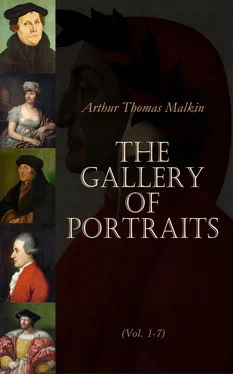To Davy, the quitting Bristol for London was the epoch of a transformation—an elevation from the chrysalis to the butterfly state. In youth his person, voice, and address were alike uncouth; and at first sight they produced so unfavourable an impression upon Count Rumford, that he expressed much regret at having sanctioned so unpromising an engagement. The veteran philosopher soon found reason to change his opinion. Davy’s first course of lectures, which was not delivered till the spring of 1802, excited a sensation unequalled before or since. Not only the philosophical but the literary and fashionable world crowded to hear him; and his vivid imagination, fired by enthusiastic love for the science which he professed, gave, to one of the most abstruse of studies, a charm confessed by persons the least likely to feel its influence. The strongest possible testimony to his richness of illustration is supplied by Mr. Coleridge:—“I go,” he said, “to Davy’s lectures to increase my stock of metaphors.” Had this been all, the young prodigy would soon have ceased to dazzle; but his fame was maintained and increased by the success which waited on his undertakings; and, in a word, Davy became the lion of the day. The effect of this sudden change was by no means good. Sought and caressed by the highest circles of the metropolis, he endeavoured to assume the deportment of a man of fashion; but the strange dress sat awkwardly, and ill replaced a natural candour and warmth of feeling, which had singularly won upon the acquaintance of his early life. It is but justice, however, to add that his regard for his family and early friends was not cooled by this alteration in his society and prospects.
Our limits are too narrow to admit even a sketch of the various trains of original investigation pursued by Davy, during his connection with the Institution. Of these, the most important is that series of electrical inquiries pursued from 1800 to 1806, the results of which were developed in his celebrated first Bakerian Lecture, delivered in the autumn of the latter year, before the Royal Society, which received from the French Institute the prize of 3000 francs, established by the First Consul, for the best experiment in electricity or galvanism. In it he investigated the nature of electric action, and disclosed a new class of phenomena illustrative of the power of the Voltaic battery in decomposing bodies; which, in the following year, led to the most striking of his discoveries, the resolution of the fixed alkalies, potash and soda, into metallic bases. This discovery took place in October, 1807, and was published in his second Bakerian Lecture, delivered in the following November. The novelty and brilliancy of the view thus opened, raised public curiosity to the highest pitch: the laboratory of the Institution was crowded with visitors, and the high excitement thus produced, acting upon a frame exhausted by fatigue, produced a violent fever, in which for many days, he lay between life and death. Not until the following March was he able to resume his duties as a lecturer.
During the next four years he was chiefly employed in endeavouring to decompose other bodies, in prosecuting his inquiries into the nature of the alkalies and in obtaining similar metallic bases from the earths, in which he partially succeeded. The resolution of nitrogen was attempted without success. In tracing the nature of muriatic and oxymuriatic acid, he was more fortunate; and proved the latter to be an undecompounded substance, in direct opposition to his own opinion, recorded at an earlier period. This discovery is the more honourable, for nothing renders the admission of truth so difficult, as having advocated error.
On the 8th April, 1812, he received the honour of knighthood from the Prince Regent, in testimony of his scientific merits. This was the more welcome, because he was on the eve of exchanging a life of professional labour for one, not of idleness, for he pursued his course of discovery with unabated zeal, but of affluence and independence. On the 11th of the same month, he married Mrs. Apreece, a lady possessed of ample fortune; previous to which he delivered his farewell lecture to the Royal Institution. At the same time he appears to have resigned the office of Secretary to the Royal Society, to which he had been appointed in 1807. Two months afterwards he published ‘Elements of Chemical Philosophy,’ which he dedicated to Lady Davy, “as a pledge that he should continue to pursue science with unabated ardour.” In March, 1813, appeared the ‘Elements of Agricultural Chemistry,’ containing the substance of a course of lectures delivered for ten successive seasons before the Board of Agriculture.
That part of the Continent which was under French influence, being strictly closed against the English at this time, it is much to the credit of Napoleon, that he immediately assented to a wish expressed by Davy, and seconded by the Imperial Institute, that he might be allowed to visit the extinct volcanoes in Auvergne, and thence proceed to make observations on Vesuvius while in a state of action. He reached Paris, Oct. 27th, 1813. The French philosophers received him with enthusiasm: it is to be regretted that at the time of his departure their feelings were much less cordial. There was a coldness, and pride, or what seemed pride, in his manner, which disgusted a body of men too justly sensible of their own merit to brook slights; especially when, in spite of national jealousy, they had done most cordial and unhesitating justice to the transcendent achievements of the British philosopher. Nor was this the only ground for dissatisfaction. Iodine had been recently discovered in Paris, but its nature was still unknown. Davy obtained a portion, and proceeded to experiment upon it. This was thought by many an unfair interference with the fame and rights of the original investigators. Davy himself felt that some explanation at least was due, in a paper which he transmitted to the Royal Society; and as the passage in question contained what, though perhaps not meant to be such, might easily be construed into an insinuation, that but for him, the results communicated in that paper might not have been obtained, it was not likely to conciliate. There is probably much truth in the excuse offered by his biographer, for the superciliousness charged against him upon this, and other occasions, that it was merely the cloak of a perpetual and painful timidity.
It is remarkable that, with a highly poetical temperament, he seems to have been senseless to the beauties of art. The wonders of the Louvre extracted no sign of pleasure: he paced the rooms with hurried steps, in apathy, roused only by the sight of an Antinous sculptured in alabaster, “Gracious Heaven!” he then exclaimed, “what a beautiful stalactite.”
From Paris, Dec. 29th, he proceeded without visiting Auvergne, to Montpellier, Genoa, Florence, Rome, and Naples, which he reached May 8th, 1814. At various places he prosecuted his researches upon iodine; and at Florence, he availed himself of the great burning lens to experiment upon the combustion of the diamond, and other forms of carbon. At Naples and Rome he instituted a minute and laborious inquiry into the colours used in painting by the ancients; the results of which appeared in the Philosophical Transactions for 1815.
The autumn of 1815 is rendered memorable by the discovery of the safety-lamp, one of the most beneficial applications of science to economical purposes yet made, by which hundreds, perhaps thousands, of lives have been preserved. Davy was led to the consideration of this subject by an application from Dr. Gray, now Bishop of Bristol, the Chairman of a Society established in 1813, at Bishop-Wearmouth, to consider and promote the means of preventing accidents by fire in coal-pits. Being then in Scotland, he visited the mines on his return southward, and was supplied with specimens of fire-damp, which, on reaching London, he proceeded to examine. He soon discovered that the carburetted hydrogen gas, called fire-damp by the miners, would not explode when mixed with less than six, or more than fourteen times its volume of air; and further, that the explosive mixture could not be fired in tubes of small diameters and proportionate lengths. Gradually diminishing their dimensions, he arrived at the conclusion that a tissue of wire, in which the meshes do not exceed a certain small diameter, which may be considered as the ultimate limit of a series of such tubes, is impervious to the inflamed air; and that a lamp covered with such tissue, may be used with perfect safety even in an explosive mixture, which takes fire, and burns within the cage, securely cut off from the power of doing harm. Thus when the atmosphere is so impure that the flame of the lamp itself cannot be maintained, the Davy still supplies light to the miner, and turns his worst enemy into an obedient servant. This invention, the certain source of large profit, he presented with characteristic liberality to the public. The words are preserved, in which when pressed to secure to himself the benefit of it by a patent, he declined to do so, in conformity with the high-minded resolution which he formed upon acquiring independent wealth, of never making his scientific eminence subservient to gain:—“I have enough for all my views and purposes, more wealth might be troublesome, and distract my attention from those pursuits in which I delight. More wealth could not increase my fame or happiness. It might undoubtedly enable me to put four horses to my carriage, but what would it avail me to have it said, that Sir Humphry drives his carriage and four?” He who used wealth and distinction to such good purpose, may be forgiven the weakness if he estimated them at too high a value.
Читать дальше












